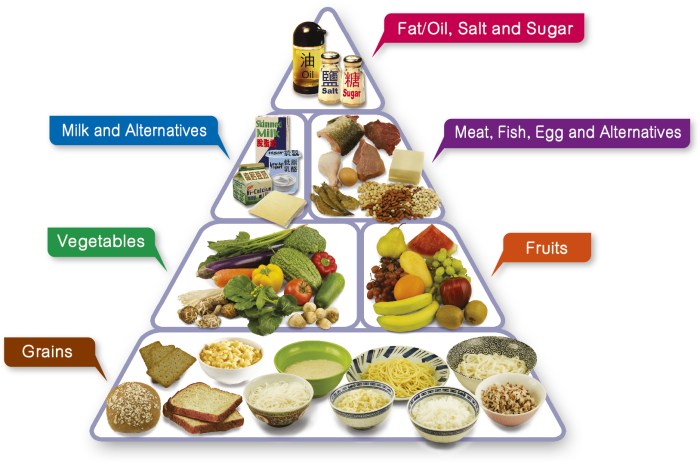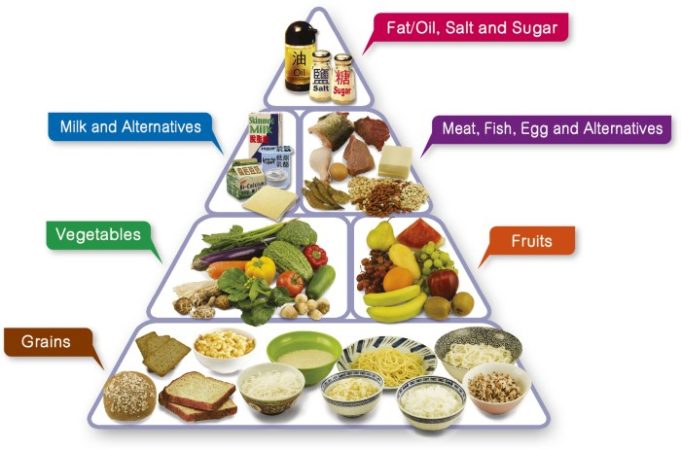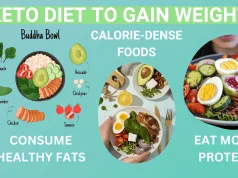How to diet properly sets the stage for a journey towards a healthier lifestyle. This guide delves into the science behind nutrition, providing practical strategies for creating a personalized diet plan that fits your unique needs and preferences. From understanding the fundamentals of balanced eating to developing sustainable habits, we’ll explore the key principles for achieving your health goals.
Dieting isn’t about deprivation; it’s about nourishing your body with the right foods and making informed choices that support your overall well-being. We’ll cover everything from setting realistic goals and incorporating mindful eating habits to managing cravings and making sustainable lifestyle changes.
Understanding Diet Basics
A well-balanced diet is crucial for overall health and well-being. It provides your body with the essential nutrients it needs to function properly, grow, and repair itself. By consuming a diverse range of foods in the right proportions, you can support your immune system, maintain a healthy weight, and reduce your risk of chronic diseases.
Macronutrients and Their Roles
Macronutrients are the essential building blocks of a healthy diet. They provide the body with energy and support various bodily functions. The three main macronutrients are carbohydrates, proteins, and fats.
- Carbohydrates are the body’s primary source of energy. They are broken down into glucose, which is used by cells for fuel. Good sources of carbohydrates include fruits, vegetables, whole grains, and legumes.
- Proteins are essential for building and repairing tissues, producing enzymes and hormones, and maintaining a healthy immune system. They are composed of amino acids, which the body cannot produce on its own. Good sources of protein include lean meats, poultry, fish, eggs, dairy products, beans, and lentils.
- Fats are important for energy storage, hormone production, and insulation. They also help absorb certain vitamins. Healthy fats, such as those found in avocados, nuts, seeds, and olive oil, are beneficial for heart health. It’s important to limit saturated and trans fats, which can increase the risk of heart disease.
Calorie Intake and Weight Management
Calories are units of energy found in food. The number of calories you consume each day determines your weight. If you consume more calories than you burn, you will gain weight. If you consume fewer calories than you burn, you will lose weight. To maintain a healthy weight, it’s important to find a balance between your calorie intake and your calorie expenditure.
The recommended daily calorie intake for adults varies based on age, sex, activity level, and other factors.
Setting Realistic Goals
Setting realistic goals is crucial for successful weight loss or maintenance. When you set achievable targets, you’re more likely to stay motivated and experience positive results. This is because unrealistic goals can lead to disappointment and frustration, making it easier to give up.
Setting SMART Goals
Setting SMART goals is a helpful framework for creating achievable and effective goals. This acronym stands for Specific, Measurable, Achievable, Relevant, and Time-bound.
- Specific: Define your goal clearly and precisely. Instead of saying “I want to lose weight,” specify “I want to lose 1-2 pounds per week.”
- Measurable: Ensure you can track your progress. Use a scale, measuring tape, or a food diary to monitor your weight, body measurements, or calorie intake.
- Achievable: Set goals that are within your reach. Losing 1-2 pounds per week is a healthy and sustainable rate of weight loss for most people.
- Relevant: Make sure your goals align with your overall health and well-being. Consider your current lifestyle, dietary habits, and physical activity level.
- Time-bound: Set a specific deadline for achieving your goal. For example, “I want to lose 10 pounds in the next two months.”
Tracking Progress
Tracking your progress towards your goals is essential for staying motivated and making adjustments as needed.
- Weight and Body Measurements: Regularly track your weight and body measurements (waist, hips, etc.) to monitor changes over time.
- Food Diary: Keep a food diary to record your daily food intake and identify areas where you can make healthier choices.
- Exercise Log: Track your exercise routine to ensure you’re meeting your activity goals.
Creating a Personalized Diet Plan
A personalized diet plan is crucial for achieving your health goals effectively. It considers your unique needs, preferences, and lifestyle, making it more likely to be sustainable and successful.
Factors to Consider When Designing a Personalized Diet Plan
Designing a personalized diet plan requires considering various factors that influence your health and dietary choices.
- Individual Needs: Your age, gender, activity level, health conditions, and medical history influence your nutritional requirements and dietary needs.
- Dietary Preferences: Incorporating foods you enjoy into your plan increases the likelihood of adherence and long-term success. Consider your favorite flavors, textures, and cultural preferences.
- Lifestyle: Your work schedule, social commitments, and access to food resources impact your dietary choices. Choose a plan that fits your lifestyle and allows for flexibility.
- Budget: Budget constraints can influence food choices. Consider affordable options while ensuring nutritional adequacy.
- Health Goals: Your goals, such as weight loss, muscle gain, or disease prevention, will guide the plan’s focus and specific recommendations.
Sample Meal Plan
Here’s a sample meal plan that includes a variety of nutrient-rich foods from all food groups, illustrating a balanced and healthy approach:
| Meal | Food Options | Nutrient Focus |
|---|---|---|
| Breakfast | Oatmeal with berries and nuts, Greek yogurt with fruit and granola, eggs with whole-grain toast and avocado | Fiber, protein, healthy fats |
| Lunch | Salmon with quinoa and roasted vegetables, lentil soup with whole-grain bread, chicken salad with mixed greens | Protein, fiber, omega-3 fatty acids |
| Dinner | Chicken stir-fry with brown rice and vegetables, baked tofu with roasted sweet potatoes and broccoli, vegetarian chili with cornbread | Protein, fiber, vitamins, minerals |
| Snacks | Fruit, vegetables, nuts, yogurt, hard-boiled eggs | Vitamins, minerals, fiber, protein |
Benefits of Consulting with a Registered Dietitian or Nutritionist
A registered dietitian or nutritionist can provide tailored guidance for creating a personalized diet plan. They are experts in nutrition science and can assess your individual needs, preferences, and goals.
- Personalized Recommendations: They can develop a plan specifically tailored to your unique needs, health conditions, and preferences.
- Evidence-Based Information: They provide evidence-based recommendations based on the latest scientific research in nutrition.
- Support and Accountability: They offer ongoing support, guidance, and accountability, helping you stay motivated and on track.
- Address Specific Concerns: They can address specific concerns, such as food allergies, intolerances, or digestive issues.
Incorporating Healthy Eating Habits
Adopting healthy eating habits is crucial for successful and sustainable weight management. These habits promote mindful eating, ensure adequate nutrient intake, and foster a positive relationship with food.
Mindful Eating, How to diet properly
Mindful eating involves paying attention to your body’s hunger and fullness cues while minimizing distractions during meals. This practice helps you eat only when truly hungry and stop when satisfied, preventing overeating.
- Pay attention to hunger cues: Before reaching for food, ask yourself if you’re truly hungry or if it’s boredom, stress, or emotional triggers. Differentiate between physical hunger (a rumbling stomach, low energy) and emotional hunger (feeling stressed, sad, or bored).
- Avoid distractions while eating: Eating in front of the TV, computer, or phone can lead to mindless consumption. Instead, focus on your meal, savor each bite, and enjoy the flavors and textures.
- Eat slowly and chew thoroughly: This allows your body time to register fullness signals, preventing overeating.
Regular Meal Timing
Regular meal timing helps regulate your body’s metabolism and blood sugar levels, promoting stable energy levels throughout the day. Skipping meals can lead to overeating later, as your body compensates for the missed nutrients.
- Establish a consistent eating schedule: Aim for three meals per day with snacks in between if needed. This helps regulate your hunger cues and prevents overeating during meals.
- Avoid skipping meals: Skipping meals can trigger cravings and lead to overeating later in the day.
Staying Hydrated
Water is essential for various bodily functions, including digestion, metabolism, and temperature regulation. Drinking plenty of water throughout the day helps prevent dehydration, which can lead to fatigue, headaches, and cravings.
- Drink water regularly: Aim for 8 glasses of water per day. You can also consume other hydrating beverages like herbal tea or unsweetened fruit juice in moderation.
- Carry a reusable water bottle: This makes it easier to stay hydrated throughout the day.
Managing Cravings and Emotional Eating
Cravings and emotional eating are common challenges for many people trying to maintain a healthy diet. Understanding the root causes and developing effective coping strategies is crucial for successful weight management and overall well-being.
Identifying Triggers and Finding Healthy Alternatives
Identifying the triggers that lead to cravings is a vital step in managing them. These triggers can be internal, such as stress, boredom, or sadness, or external, such as the sight or smell of tempting foods. Once you’ve identified your triggers, you can start developing strategies to avoid them or find healthier alternatives.
For example, if you find yourself craving sweets after a stressful day at work, try engaging in a relaxing activity like taking a walk, listening to music, or reading a book. If you’re craving salty snacks while watching TV, keep a bowl of fruits or vegetables nearby.
Coping Mechanisms for Emotional Eating
Emotional eating is a complex issue that often stems from underlying emotional distress. It’s important to develop healthy coping mechanisms to manage these emotions without resorting to food.
Examples of Coping Mechanisms
- Engaging in Physical Activity: Exercise can be a powerful stress reliever and can help to reduce cravings. A brisk walk, a yoga session, or a dance class can help to clear your head and boost your mood.
- Talking to a Trusted Friend: Sharing your feelings with a trusted friend or family member can help you to process your emotions and gain a fresh perspective.
- Practicing Mindfulness: Mindfulness techniques, such as meditation or deep breathing exercises, can help you to become more aware of your emotions and cravings, allowing you to make more conscious choices.
- Journaling: Writing down your thoughts and feelings can be a helpful way to process your emotions and identify patterns in your emotional eating.
Self-Compassion and Avoiding Harsh Self-Criticism
It’s important to approach your journey with self-compassion and avoid harsh self-criticism. Remember that everyone makes mistakes, and it’s okay to have setbacks. Instead of beating yourself up, focus on learning from your experiences and moving forward.
“Be kind to unkind people. They need it most.” — The Dalai Lama
Making Sustainable Lifestyle Changes
A successful diet plan isn’t just about achieving short-term weight loss; it’s about building lasting healthy habits that you can maintain over the long term. The key is to make gradual, sustainable changes that fit seamlessly into your lifestyle. By incorporating healthy choices into your daily routine, you’ll find it easier to stay motivated and reach your goals.
Dieting properly involves understanding your body’s needs and finding a sustainable plan that works for you. Just like humans, dogs have different dietary requirements, and you might wonder if a raw diet is the right choice for your furry friend.
If you’re curious about the benefits and drawbacks of a raw diet for dogs, check out this informative article: is a raw diet good for dogs. Ultimately, a balanced diet tailored to your dog’s age, breed, and activity level is key to their overall health and well-being.
Gradually Incorporating Healthy Habits
Instead of drastically overhauling your entire diet overnight, focus on making small, incremental changes. This approach is less overwhelming and more likely to lead to long-term success.
Dieting effectively is about making sustainable changes to your eating habits, and fiber plays a crucial role in that process. To ensure you’re getting the right amount, it’s important to understand how much dietary fiber per day is recommended for your individual needs.
By incorporating plenty of fiber-rich foods into your diet, you’ll not only feel fuller for longer, but you’ll also support your digestive health and overall well-being.
- Start with one or two areas you want to improve, such as increasing your water intake or incorporating more fruits and vegetables into your meals. Once you’ve mastered those changes, you can gradually add more.
- Replace unhealthy habits with healthier alternatives. For example, swap sugary drinks for water or unsweetened tea, or choose air-popped popcorn over potato chips.
- Make gradual substitutions in your meals. Instead of eliminating your favorite foods entirely, try incorporating healthier versions or reducing portion sizes. For instance, switch from full-fat yogurt to low-fat or Greek yogurt, or opt for a smaller serving of your favorite dessert.
Maintaining Motivation and Consistency
Staying motivated with any lifestyle change can be challenging. Here are some tips to help you stay on track:
- Set realistic goals. Aim for small, achievable changes rather than trying to make drastic transformations all at once. This will help you feel a sense of accomplishment and prevent discouragement.
- Find a support system. Share your goals with friends, family, or a support group. Having people who understand your journey and offer encouragement can make a big difference.
- Celebrate your successes. Acknowledge your progress, no matter how small. This will help you stay motivated and reinforce positive behaviors.
- Track your progress. Keeping a food journal or using a fitness tracker can help you stay accountable and see how far you’ve come. This can be a powerful motivator.
- Be kind to yourself. Everyone makes mistakes. If you slip up, don’t beat yourself up about it. Just get back on track as soon as you can. Focus on the overall progress you’re making, not on occasional setbacks.
Finding Enjoyable Activities that Support Healthy Eating and Weight Management
Making healthy choices should be enjoyable, not a chore. Find activities that you genuinely enjoy and that support your weight management goals. This will help you stay motivated and make healthy choices a part of your lifestyle.
A balanced diet is crucial for weight management, but sometimes we crave a sweet treat. You might wonder if a diet soda like Diet Coke fits into your plan, especially if you’re sensitive to caffeine. It’s worth checking out is diet coke caffeine free to see if it aligns with your dietary goals.
Remember, moderation is key, and a healthy diet should be a lifestyle choice, not just a temporary fix.
- Explore different cuisines and recipes. Cooking at home can be a fun and rewarding way to experiment with healthy ingredients and create delicious meals. There are countless healthy recipes available online and in cookbooks.
- Join a cooking class. This can be a great way to learn new techniques and recipes while socializing with others who share your interest in healthy eating.
- Find an exercise buddy. Having a workout partner can help you stay motivated and accountable. Choose an activity that you both enjoy, whether it’s hiking, swimming, dancing, or playing a sport.
- Join a fitness group or club. This can provide a sense of community and support, and it can also expose you to new activities that you might enjoy.
- Take up a new hobby. Hobbies can be a great way to de-stress and stay active. Choose something that you find enjoyable and that fits into your lifestyle.
Summary: How To Diet Properly

By embracing the principles Artikeld in this guide, you can embark on a transformative journey toward a healthier you. Remember, sustainable changes take time, so be patient with yourself and celebrate your progress along the way. With dedication and a positive mindset, you can achieve your health goals and enjoy the benefits of a well-balanced diet for years to come.
Essential FAQs
What are some healthy snack options?
Fruits, vegetables, nuts, yogurt, and hard-boiled eggs are excellent healthy snack choices.
How many calories should I eat per day?
Calorie needs vary based on factors like age, activity level, and metabolism. Consult with a healthcare professional or registered dietitian for personalized recommendations.
Is it okay to skip meals?
Skipping meals can disrupt your metabolism and lead to overeating later. It’s generally recommended to eat regular meals throughout the day.
How do I deal with food cravings?
Identify your cravings triggers and find healthy alternatives. Engage in physical activity, drink water, or distract yourself with other activities.
























